Does Bitcoin Hedge Commodity Uncertainty?
Abstract
1. Introduction
2. Literature Review
3. Methodology
4. Data Analysis
4.1. Data
4.2. Empirical Results
4.3. Robustness Test
5. Conclusions
Author Contributions
Funding
Conflicts of Interest
References
- Ardia, David, Keven Bluteau, and Maxime Rüede. 2019. Regime changes in Bitcoin GARCH volatility dynamics. Finance Research Letters 29: 266–71. [Google Scholar] [CrossRef]
- Baek, Chung, and Matthew A. Elbeck. 2015. Bitcoins as an investment or speculative vehicle? A first look. Applied Economics Letters 22: 30–34. [Google Scholar] [CrossRef]
- Bariviera, Aurelio F. 2017. The inefficiency of Bitcoin revisited: A dynamic approach. Economics Letters 161: 1–4. [Google Scholar] [CrossRef]
- Baruník, Jozef, and Tomáš Křehlík. 2018. Measuring the frequency dynamics of financial connectedness and systemic risk. Journal of Financial Econometrics 16: 271–96. [Google Scholar] [CrossRef]
- Baumöhl, Eduard. 2019. Are cryptocurrencies connected to forex? A quantile cross-spectral approach. Finance Research Letters 29: 363–72. [Google Scholar] [CrossRef]
- Baur, Dirk G., KiHoon Hong, and Adrian D. Lee. 2018. Bitcoin: Medium of exchange or speculative assets? Journal of International Financial Markets, Institutions and Money 54: 177–89. [Google Scholar] [CrossRef]
- Bianchi, Daniele. Forthcoming. Cryptocurrencies as an asset class? An empirical assessment. Journal of Alternative Investment.
- Beneki, Christina, Alexandros Koulis, Nikolaos A. Kyriazis, and Stephanos Papadamou. 2019. Investigating volatility transmission and hedging properties between Bitcoin and Ethereum. Research in International Business and Finance 48: 219–27. [Google Scholar] [CrossRef]
- Böhme, Rainer, Nicolas Christin, and Benjamin Edelman. 2015. Bitcoin: Economcis, technology, and governance. Journal of Economics Perspectives 29: 213–38. [Google Scholar] [CrossRef]
- Bouri, Elie, Georges Azzi, and Anne H. Dyhrberg. 2017a. On the return-volatility relationship in the Bitcoin market around the price crash of 2013. Economics: The Open-Access, Open-Assessment E-Journal 11: 1–16. [Google Scholar]
- Bouri, Elie, Rangan Gupta, Aviral K. Tiwari, and David Roubaud. 2017b. Does Bitcoin hedge global uncertainty? Evidence from wavelet-based quantile-in-quantile regressions. Finance Research Letters 23: 87–95. [Google Scholar] [CrossRef]
- Bouri, Elie, Peter Molnár, Georges Azzi, David Roubaud, and Lars I. Hagfors. 2017c. On the hedge and safe haven properties of Bitcoin: Is it really more than a diversifier? Finance Research Letters 20: 192–98. [Google Scholar] [CrossRef]
- Bouri, Elie, Rangan Gupta, Chi K.M. Lau, David Roubaud, and Shixuan Wang. 2018. Bitcoin and global financial stress: A copula-based approach to dependence and causality in the quantiles. The Quarterly Review of Economics and Finance 69: 297–307. [Google Scholar] [CrossRef]
- Carrick, Jon. 2016. Bitcoin as a complement to emerging market currencies. Emerging Markets Finance and Trade 52: 2321–34. [Google Scholar] [CrossRef]
- Catania, Leopoldo, Stefano Grassi, and Francesco Ravazzolo. 2019. Forecasting cryptocurrencies under model and parameter instability. International Journal of Forecasting 35: 485–501. [Google Scholar] [CrossRef]
- Chicago Board Options Exchange (CBOE). 2018. Volatility Indexes. Available online: http://www.cboe.com/products/vix-index-volatility/volatility-indexes (accessed on 20 January 2019).
- Chaim, Pedro, and Márcio P. Laurini. 2018. Volatility and return jumps in bitcoin. Economics Letters 173: 158–63. [Google Scholar] [CrossRef]
- Charles, Amélie, and Olivier Darné. 2019. Volatility estimation for Bitcoin: Replication and robustness. International Economics 157: 23–32. [Google Scholar] [CrossRef]
- Cheah, Eng-Tuck, and John Fry. 2015. Speculative bubbles in Bitcoin markets? An empirical investigation into the fundamental value of Bitcoin. Economics Letters 130: 32–36. [Google Scholar] [CrossRef]
- Ciaian, Pavel, Miroslava Rajcaniova, and d’Artis Kancs. 2016. The economics of BitCoin price formation. Applied Economics 48: 1799–815. [Google Scholar] [CrossRef]
- Corbet, Shaen, Brian Lucey, Maurice Peat, and Samuel Vigne. 2018. Bitcoin Futures—What use are they? Economics Letters 172: 23–27. [Google Scholar] [CrossRef]
- Demir, Ender, Giray Gozgor, Chi K.M. Lau, and Samuel A. Vigne. 2018. Does economic policy uncertainty predict the Bitcoin returns? An empirical investigation. Finance Research Letters 26: 145–49. [Google Scholar] [CrossRef]
- Diebold, Francis X., and Kamil Yilmaz. 2012. Better to give than to receive: Predictive directional measurement of volatility spillovers. International Journal of Forecasting 28: 57–66. [Google Scholar] [CrossRef]
- Dyhrberg, Anne H. 2016a. Bitcoin, gold and the dollar–A GARCH volatility analysis. Finance Research Letters 16: 85–92. [Google Scholar] [CrossRef]
- Dyhrberg, Anne H. 2016b. Hedging capabilities of bitcoin. Is it the virtual gold? Finance Research Letters 16: 139–44. [Google Scholar] [CrossRef]
- Feng, Wenjun, Yiming Wang, and Zhengjun Zhang. 2018. Informed trading in the Bitcoin market. Finance Research Letters 26: 63–70. [Google Scholar] [CrossRef]
- Fry, John. 2018. Booms, busts and heavy-tails: The story of Bitcoin and cryptocurrency markets? Economics Letters 171: 225–29. [Google Scholar] [CrossRef]
- Fry, John, and Eng-Tuck Cheah. 2016. Negative bubbles and shocks in cryptocurrency markets. International Review of Financial Analysis 47: 343–52. [Google Scholar] [CrossRef]
- Katsiampa, Paraskevi. 2017. Volatility estimation for Bitcoin: A comparison of GARCH models. Economics Letters 158: 3–6. [Google Scholar] [CrossRef]
- Kim, Thomas. 2017. On the transaction cost of Bitcoin. Finance Research Letters 23: 300–5. [Google Scholar] [CrossRef]
- Klein, Tony, Hien T. Pham, and Thomas Walther. 2018. Bitcoin is not the New Gold—A comparison of volatility, correlation, and portfolio performance. International Review of Financial Analysis 59: 105–16. [Google Scholar] [CrossRef]
- Koutmos, Dimitrious. 2018. Return and volatility spillovers among cryptocurrencies. Economics Letters 173: 122–27. [Google Scholar] [CrossRef]
- Kristoufek, Ladislav. 2013. BitCoin meets Google Trends and Wikipedia: Quantifying the relationship between phenomena of the Internet era. Scientific Reports 3: 3415. [Google Scholar] [CrossRef] [PubMed]
- Kyriazis, Nikolaos A. 2019. A survey on efficiency and profitable trading opportunities in cryptocurrencies markets. Journal of Risk and Financial Management 12: 67. [Google Scholar] [CrossRef]
- Kyriazis, Nikolaos A. 2020. Is Bitcoin similar to gold? An integrated overview of empirical findings. Journal of Risk and Financial Management 13: 88. [Google Scholar] [CrossRef]
- Kyriazis, Nikolaos A., Kalliopi Daskalou, Marios Arampatzis, Paraskevi Prassa, and Evangelia Papaioannou. 2019. Estimating the volatility of cryptocurrencies during bearish markets by employing GARCH models. Heliyon 5: e02239. [Google Scholar] [CrossRef]
- Mensi, Walid, Aviral Tiwari, Elie Bouri, David Roubaud, and Khamis H. Al-Yahyaee. 2017. The dependence structure across oil, wheat, and corn: A wavelet-based copula approach using implied volatility indexes. Energy Economics 66: 122–39. [Google Scholar] [CrossRef]
- Nadarajah, Sarelees, and Jeffrey Chu. 2017. On the inefficiency of Bitcoin. Economics Letters 150: 6–9. [Google Scholar] [CrossRef]
- Patton, Andrew J. 2004. On the out-of-sample importance of skewness and asymmetric dependence for asset allocation. Journal of Financial Econometrics 2: 130–68. [Google Scholar] [CrossRef]
- Pieters, Gina, and Sofia Vivanco. 2017. Financial regulations and price inconsistencies across Bitcoin markets. Information Economics and Policy 39: 1–14. [Google Scholar] [CrossRef]
- Polasik, Michal, Anna I. Piotrowska, Tomasz P. Wisniewski, Radoslaw Kotkowski, and Geoffrey Lightfoot. 2015. Price fluctuations and the use of Bitcoin: An empirical inquiry. International Journal of Electronic Commerce 20: 9–49. [Google Scholar] [CrossRef]
- Troster, Victor, Aviral K. Tiwari, Muhammad Shahbaz, and Demian N. Macedo. 2019. Bitcoin returns and risk: A general GARCH and GAS analysis. Finance Research Letters 30: 187–93. [Google Scholar] [CrossRef]
- Tiwari, Aviral K., Rabin Jana, Debojyoti Das, and David Roubaud. 2018. Informational efficiency of Bitcoin-An extension. Economics Letters 163: 106–9. [Google Scholar] [CrossRef]
- Urquhart, Andrew. 2016. The inefficiency of Bitcoin. Economics Letters 148: 80–82. [Google Scholar] [CrossRef]
- Vidal-Tomás, David, and Ana Ibañez. 2018. Semi-strong efficiency of Bitcoin. Finance Research Letters 27: 259–65. [Google Scholar] [CrossRef]
- Weber, Beat. 2016. Bitcoin and the legitimacy crisis of money. Cambridge Journal of Economics 40: 17–41. [Google Scholar] [CrossRef]
- Wu, Feng, Zhengfei Guan, and Robert J. Myers. 2011. Volatility spillover effects and cross hedging in corn and crude oil futures. Journal of Futures Markets 31: 1052–75. [Google Scholar] [CrossRef]
- Yelowitz, Aaron, and Matthew Wilson. 2015. Characteristics of Bitcoin users: an analysis of Google search data. Applied Economics Letters 22: 1030–36. [Google Scholar] [CrossRef]
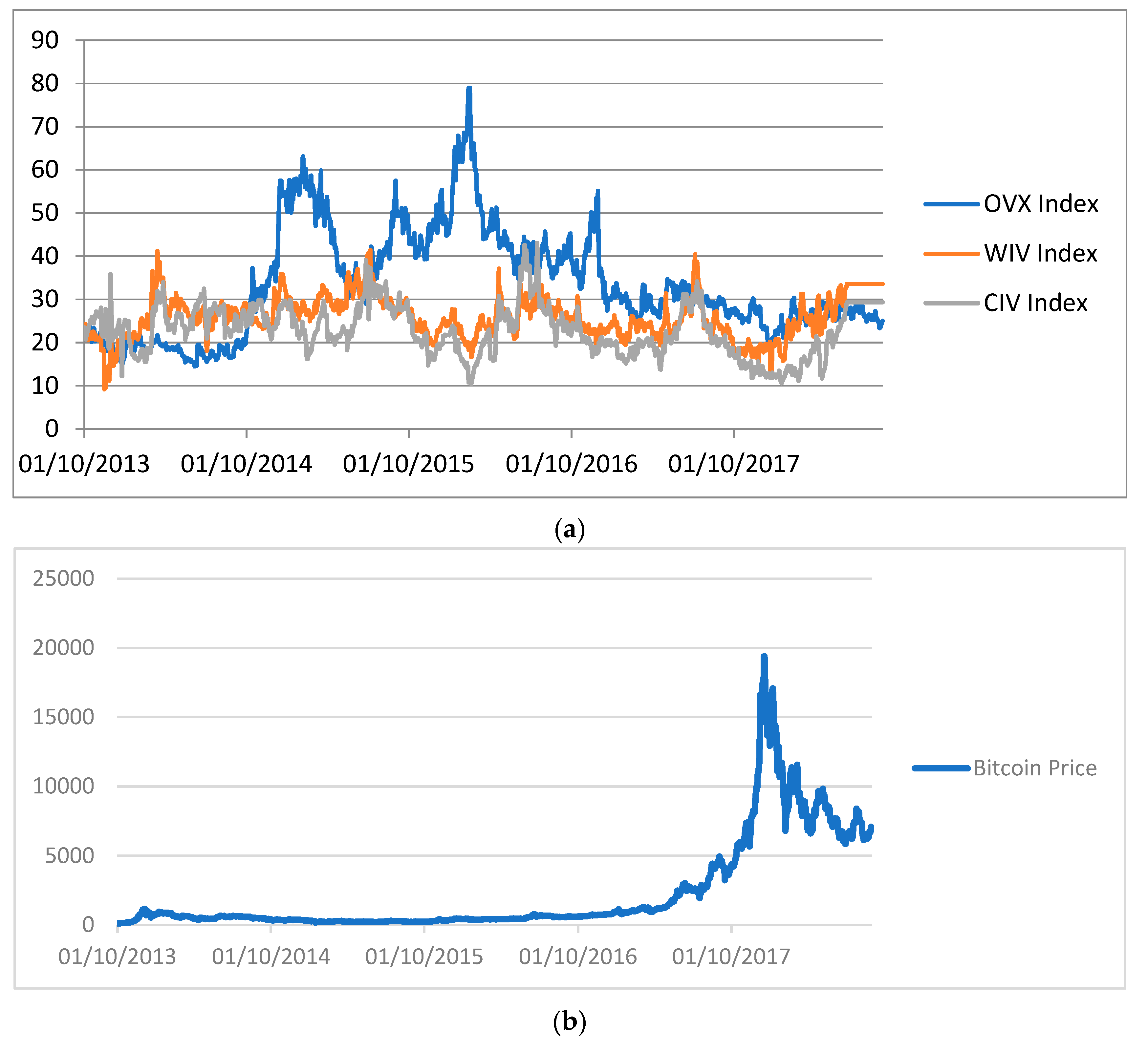
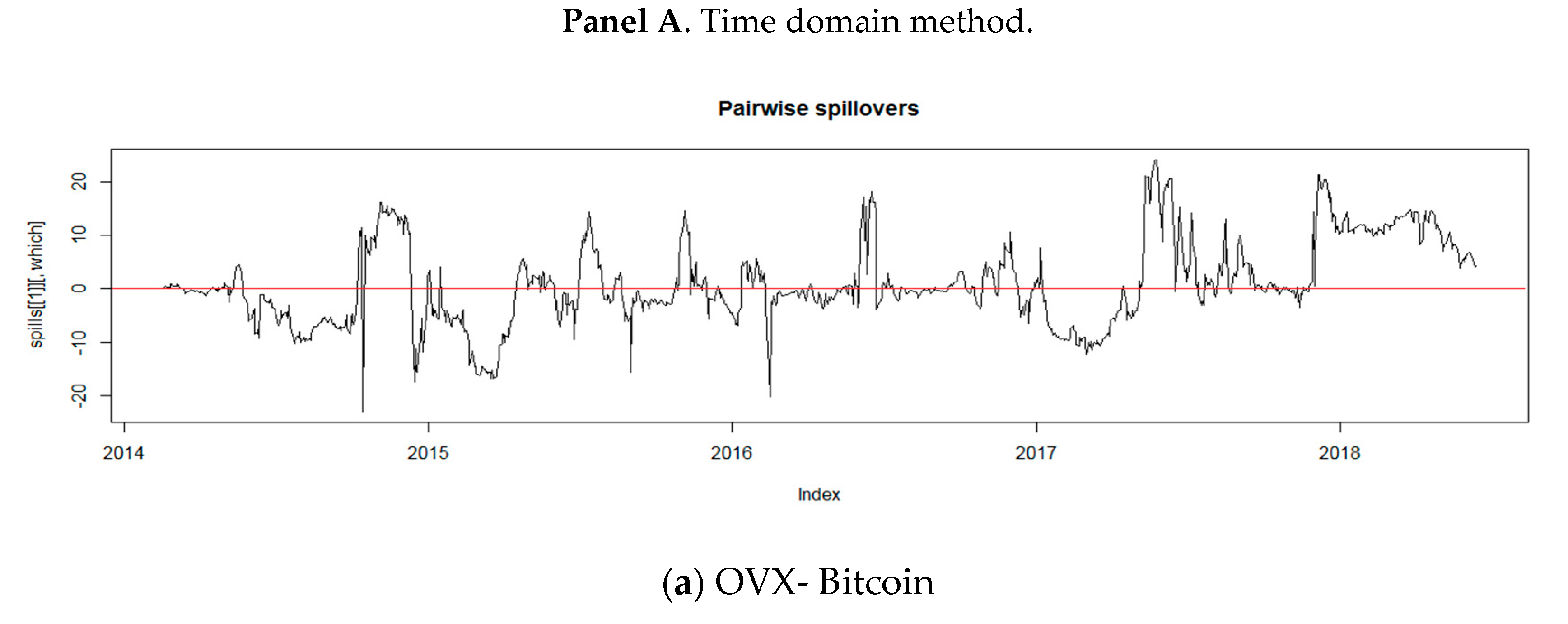

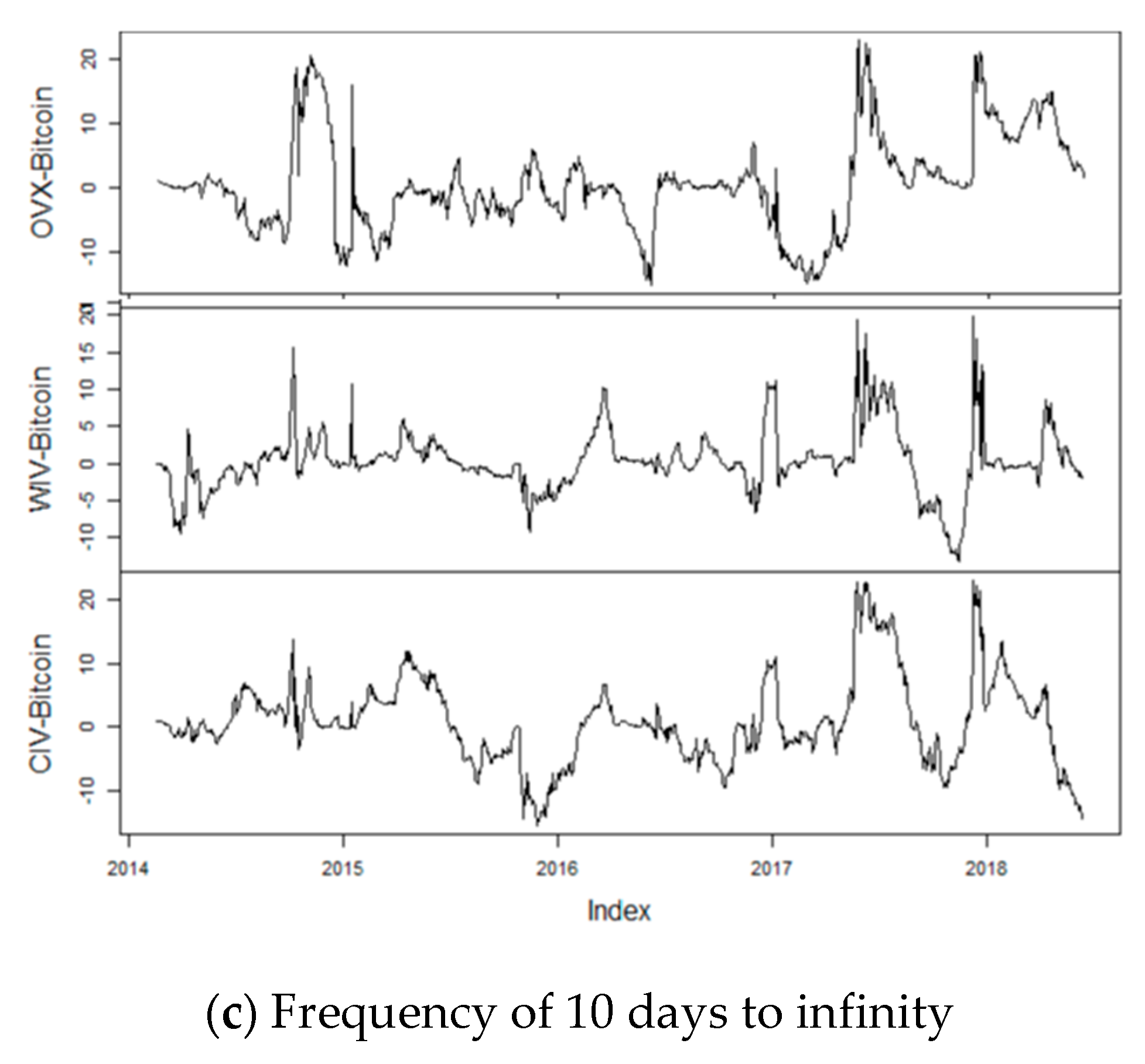
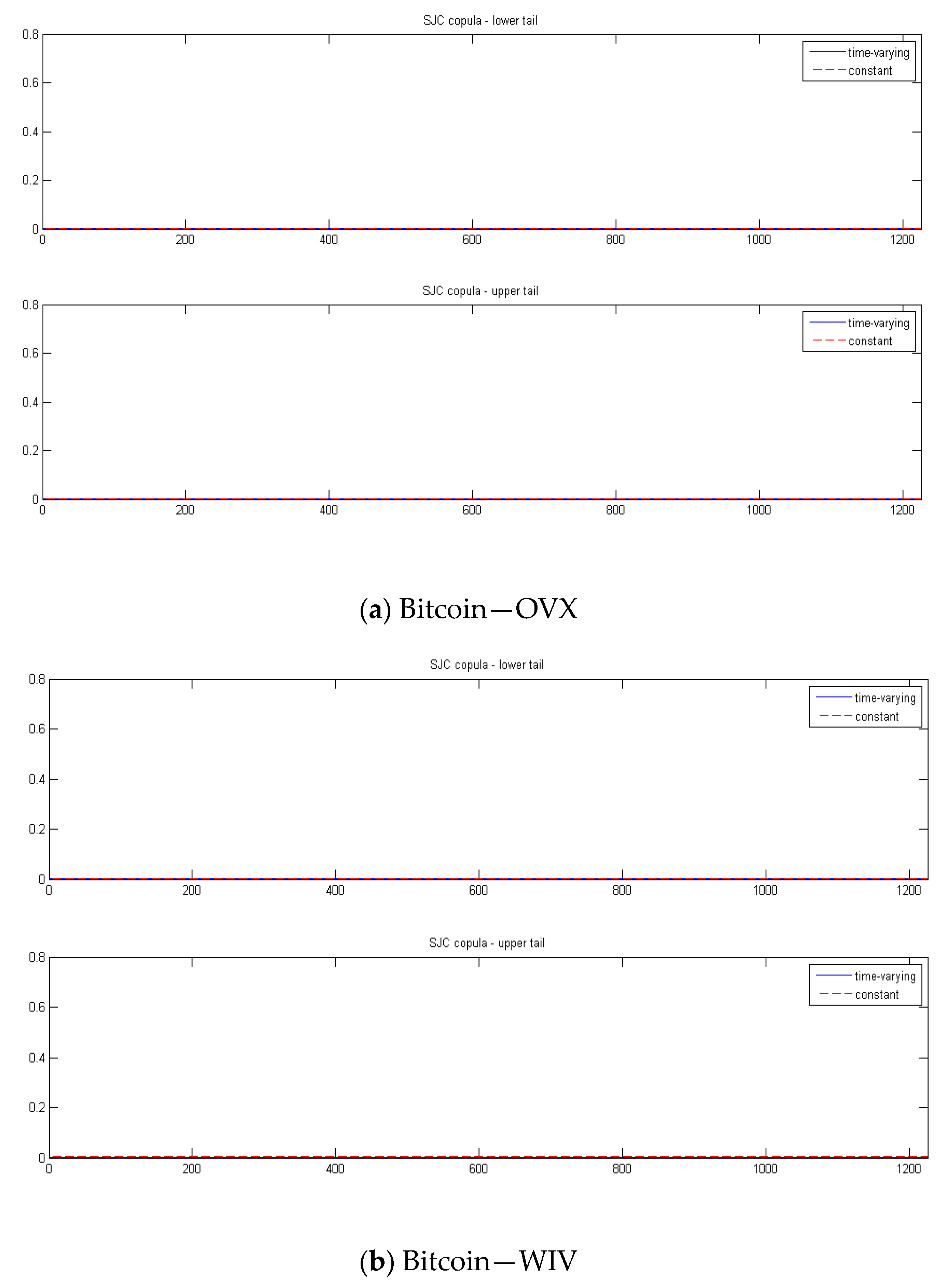
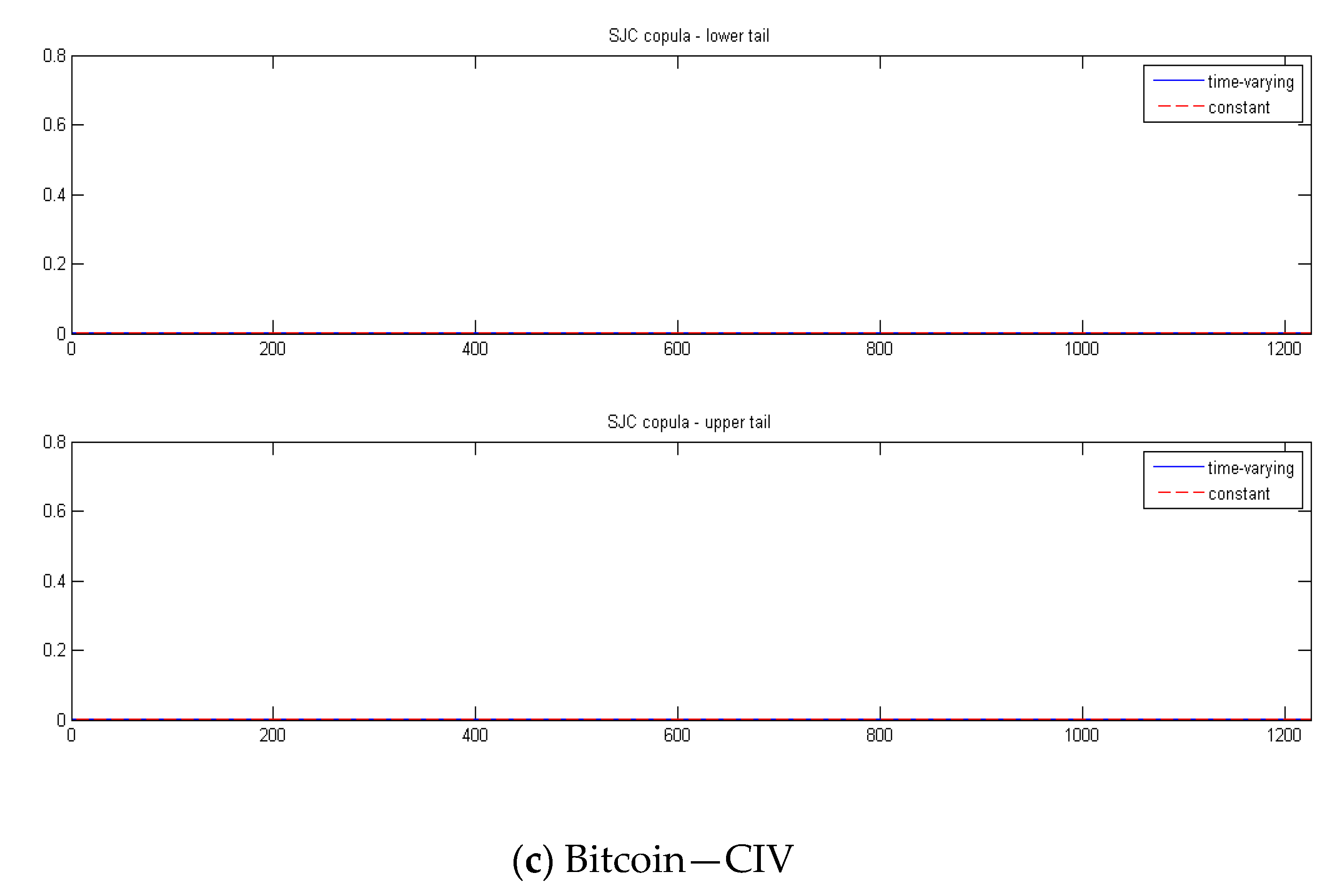
| OVX | WIV | CIV | Bitcoin | |
|---|---|---|---|---|
| Return Mean | 0.0001 | 0.0003 | 0.0002 | 0.0033 |
| Index Mean | 33.65 | 25.45 | 22.52 | 2050.2 |
| Median | 30.79 | 25.23 | 22.34 | 591.9 |
| Maximum | 78.97 | 41.39 | 43.09 | 19,395.8 |
| Minimum | 14.50 | 9.19 | 10.40 | 100.8 |
| 1st Quarter | 24.07 | 22.46 | 18.55 | 367.8 |
| 3rd Quarter | 42.21 | 28.46 | 26.49 | 1226.8 |
| Jarque–Bera test | 93.948 (<0.0001) | 15.433 (0.0004) | 13.459 (0.0012) | 2626.8 (<0.0001) |
| ADF test | –2.083 (0.5432) | –3.6331 (0.02949) | –4.0686 (0.01) | –2.064 (0.5512) |
| Correlation with Bitcoin | –0.0314 | 0.0628 | 0.0116 | 1 |
| OVX | WIV | CIV | Bitcoin | From | |
|---|---|---|---|---|---|
| OVX | 84.67 | 7.18 | 6.06 | 2.09 | 3.83 |
| WIV | 0.16 | 77.56 | 20.77 | 1.51 | 5.61 |
| CIV | 2.08 | 33.23 | 58.11 | 6.58 | 10.47 |
| Bitcoin | 0.14 | 9.64 | 4.51 | 85.71 | 3.57 |
| To | 0.60 | 12.51 | 7.83 | 2.55 | 23.49 |
| Frequency 1. The spillover table for band: 3.14 to 0.79. Roughly corresponds to 1 day to 4 days. | ||||||
| OVX | WIV | CIV | Bitcoin | From.ABS | From.WTH | |
| OVX | 0.32 | 0.02 | 0.02 | 0.01 | 0.01 | 0.66 |
| WIV | 0.01 | 3.15 | 0.90 | 0.05 | 0.24 | 12.41 |
| CIV | 0.04 | 0.49 | 2.51 | 0.02 | 0.14 | 7.19 |
| Bitcoin | 0.00 | 0.06 | 0.01 | 0.06 | 0.02 | 0.91 |
| To.ABS | 0.01 | 0.14 | 0.23 | 0.02 | 0.41 | |
| To.WTH | 0.71 | 7.46 | 12.01 | 0.98 | 21.16 | |
| Frequency 2. The spillover table for band: 0.79 to 0.31. Roughly corresponds to 4 days to 10 days. | ||||||
| OVX | WIV | CIV | Bitcoin | From.ABS | From.WTH | |
| OVX | 0.61 | 0.07 | 0.04 | 0.03 | 0.04 | 1.25 |
| WIV | 0.02 | 5.21 | 1.17 | 0.12 | 0.33 | 11.54 |
| CIV | 0.03 | 0.75 | 3.02 | 0.03 | 0.20 | 7.07 |
| Bitcoin | 0.00 | 0.15 | 0.04 | 0.06 | 0.05 | 1.62 |
| To.ABS | 0.01 | 0.24 | 0.31 | 0.04 | 0.61 | |
| To.WTH | 0.40 | 8.53 | 11.03 | 1.52 | 21.47 | |
| Frequency 3. The spillover table for band: 0.31 to 0.00. Roughly corresponds to more than 10 days. | ||||||
| OVX | WIV | CIV | Bitcoin | From.ABS | From.WTH | |
| OVX | 83.74 | 7.08 | 6.00 | 2.06 | 3.79 | 3.97 |
| WIV | 0.13 | 69.20 | 18.70 | 1.35 | 5.04 | 5.30 |
| CIV | 2.01 | 31.99 | 52.57 | 6.54 | 10.14 | 10.64 |
| Bitcoin | 0.13 | 9.43 | 4.47 | 85.59 | 3.51 | 3.68 |
| To.ABS | 0.57 | 12.13 | 7.29 | 2.48 | 22.47 | |
| To.WTH | 0.60 | 12.73 | 7.66 | 2.61 | 23.60 | |
| Total DY (2012) Time Domain | OVX-Bitcoin | WIV-Bitcoin | CIV-Bitcoin |
|---|---|---|---|
| 0.489 | −2.031 | 0.516 | |
| BK (2018)-Frequency domain | |||
| Frequency 1 | OVX-Bitcoin | WIV-Bitcoin | CIV-Bitcoin |
| 0.002 | −0.002 | 0.001 | |
| Frequency 2 | OVX-Bitcoin | WIV-Bitcoin | CIV-Bitcoin |
| 0.006 | −0.006 | −0.002 | |
| Frequency 3 | OVX-Bitcoin | WIV-Bitcoin | CIV-Bitcoin |
| 0.480 | −2.022 | 0.517 | |
© 2020 by the authors. Licensee MDPI, Basel, Switzerland. This article is an open access article distributed under the terms and conditions of the Creative Commons Attribution (CC BY) license (http://creativecommons.org/licenses/by/4.0/).
Share and Cite
Hoang, K.; Nguyen, C.C.; Poch, K.; Nguyen, T.X. Does Bitcoin Hedge Commodity Uncertainty? J. Risk Financial Manag. 2020, 13, 119. https://doi.org/10.3390/jrfm13060119
Hoang K, Nguyen CC, Poch K, Nguyen TX. Does Bitcoin Hedge Commodity Uncertainty? Journal of Risk and Financial Management. 2020; 13(6):119. https://doi.org/10.3390/jrfm13060119
Chicago/Turabian StyleHoang, Khanh, Cuong C. Nguyen, Kongchheng Poch, and Thang X. Nguyen. 2020. "Does Bitcoin Hedge Commodity Uncertainty?" Journal of Risk and Financial Management 13, no. 6: 119. https://doi.org/10.3390/jrfm13060119
APA StyleHoang, K., Nguyen, C. C., Poch, K., & Nguyen, T. X. (2020). Does Bitcoin Hedge Commodity Uncertainty? Journal of Risk and Financial Management, 13(6), 119. https://doi.org/10.3390/jrfm13060119





